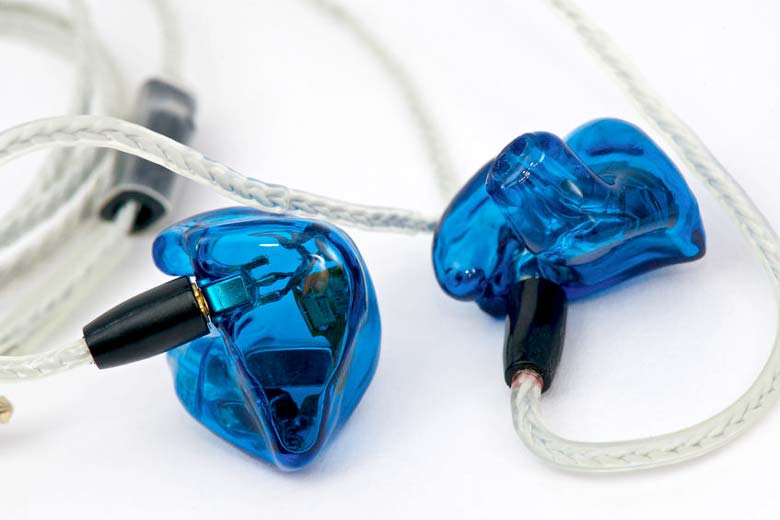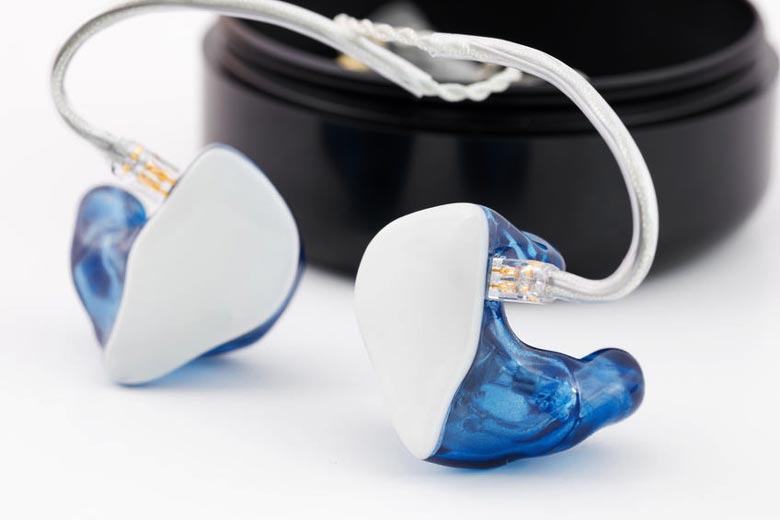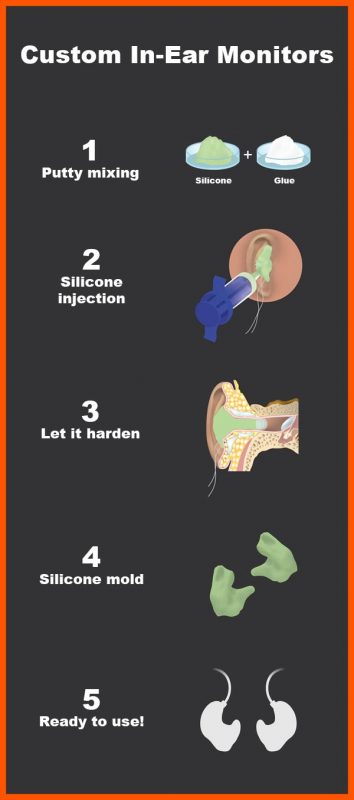Custom in-ear monitors (IEMs) are becoming more popular due to their comfort and sound quality. They provide a better fit than standard headphones because, as the name would suggest, they are customized to perfectly fit the wearer’s ears. Custom IEMs come in a wide range of prices and designs, each created to give its owner the best audio listening experience.
Custom IEMs are an in-ear monitor made using molds of the inner ear to produce a snug but comfortable fit. These headphones are designed to be lightweight, portable, and secure. Custom IEMs are used on stage, in recording studios, and by audiophiles looking for the best sound experience.
This article will discuss how custom IEMs work and explain the difference between in-ear monitors and standard in-ear headphones. You will also learn how designers match their custom IEMs to the individual’s ear.

History of Custom IEMs
In 1982, sound engineer Marty Garcia created a pair of custom-fit earphones for Todd Rundgren. Using denture adhesive, Garcia molded an outer-ear seal which kept Rundgren’s earphones snug and secure during performing, recording, and production.
In 1985, Rundgren’s Utopia Tour was the first to feature a “wedgeless stage.”
Wedge monitors (onstage speakers), which send the sound directly toward the performers, helped musicians follow their music over blaring PA systems and a roaring crowd.
But wedge monitors add more decibels to the already overwhelming noise. Singers often had to scream to hear themselves above the din.
With a stage full of musicians turning up their volume to compensate, performers and sound engineers found themselves trapped in a vicious circle.
The Utopia Tour had no such problems. Each band member heard their music directly from the mixing board, thanks to Garcia’s Future Sonics Ear Monitors.
Other musicians began using FS Ear Monitors for performances: early adapters included Reba McIntire and Phil Collins.
In 1995, sound engineer Jerry Harvey designed the first custom IEMs for drummer Alex Van Halen.
Using a mold of Alex’s inner ear, Harvey created a personalized ear monitor that allowed him to follow his bandmates over the noise.
Harvey went on to sell many copies of his Custom Ultimate Ears earphones. Today, many companies are offering custom earphones exclusively or alongside their off-the-shelf products.
Why “In-Ear Monitors” and Not “Earphones”?
Most earphones are created to flatter music by elevating the low end for more enjoyable bass and raising the high end to give an impression of added detail. This “smile curve” appears in most home audio equipment.
However, musicians and recording engineers want to hear the music as is – warts and all.
Sound technicians can’t correct the mistakes they cannot hear and are listening not for entertainment but for getting a job done.
With that in mind, they need unadulterated music, not something tweaked for listening pleasure.
When music professionals do their job correctly, their work will sound good without any outside intervention. Of course, that’s not always possible, and producers will work with the tracks to make them perfect.
That said, many hardcore listeners want to hear the music just as the musicians and professionals intended.
They will put up with the flaws of poorly recorded material to enjoy the true glory of great music performed by talented musicians and recorded by excellent engineers.
These are the listeners that may look to IEMs in place of standard headphones.

Where Are Custom IEMs Used?
Custom IEMs find use in many venues, and though they got their start with performing artists, you can see them in recording studios and in-home headphone collections all over the world.
Performers Use Custom IEMs Onstage
Most major concert tours today use IEMs. When you see a musician onstage wearing earbuds and a walkie-talkie-sized box on their belt, they use IEMs.
The box in their belt pack is a receiver. The receiver contains a jack that connects the earphones and a volume knob the performer uses to adjust the playback level.
The connection between headphones and the receiver is wired, but the receiver’s connection to the transmitter is usually wireless. A transmitter sends the monitor mix, which the sound engineer hears at the mixing board, to the performers.
Professional wireless systems operate on the VHF or UHF frequencies used for television broadcasts. Licensed TV station’s VHF and UHF signals typically work within a predictable range. Sound engineers can account for this interference when assigning bands to wireless IEMs.
Wi-Fi signals like Bluetooth are less monitored, and though it is okay for casual listening, it has short range and can be prone to interference. Being less monitored, accounting for interference becomes more difficult.
Bluetooth’s limited bandwidth also precludes streaming the highest-quality audio. Musicians performing on an arena-sized stage need a more robust, clearer signal.
VHF and UHF frequencies also operate on longer wavelengths than Bluetooth, giving them a more extended range and making them better at penetrating obstacles between the transmitter and performer.

IEM vs. Wedge Monitors
Wireless IEMs offer many advantages over conventional wedge monitors. These include:
- A performer who moves too far away from the wedge may have difficulty hearing its output. Or, they may find the monitor unable to keep up with the venue’s ambient noise.
- Wireless IEMs ensure the performer hears the same sound from any point on the stage. This is critical for singers that like to move across the stage as they perform.
- Most wireless setups give each performer a personal channel that foregrounds their instrument. Each musician needs to hear if they are in key and on the beat. However, they can still hear the other musicians, too.
- When a stage mic picks up the sound from a wedge monitor, painful feedback may result. Because IEMs transmit the music directly to a performer’s ears, there is no danger of feedback loops.
- Wireless IEMs are far lighter and less bulky than wedge monitors. This gives the artist much more freedom in their movement, including out into the crowd should they choose it.
- Wedge monitors add to the noise. The tight seal of Custom IEMs blocks 26dB or more of the outside sound. (For comparison, earplugs block between 22dB and 33dB.)
Most professional touring acts rent their wireless IEM setups, and their rental contract ensures quick replacement of any damaged or malfunctioning unit.
Related Article: How To Set Up In-Ear Monitors for Singers
But many performers want better sound than they receive from the generic earbuds that come with their rentals. Custom IEMs offer them more accurate monitoring.
Producers Use Custom IEMs in Recording Studios
Recording engineers and producers spend hours listening closely to their musical projects. Headphones have always been their preferred monitoring tool but can get sweaty and uncomfortable after long listening sessions.
A well-fitted custom IEM is more comfortable than an ill-fitting set of over-ear headphones, plus they are lighter and less fatiguing. Their ear seal also makes them better at keeping out background noise.
Many recording engineers still feel that in-ear headphones do not reproduce dynamic range and bass as accurately as over-ears. But the best Custom IEMs produce a flat signal with abundant but not overstated bass and dynamic range that plays soft and loud passages just as recorded.
It used to be that recording an album meant spending thousands of dollars to rent a studio and hire professional engineers. Today, many artists record in their homes using software like Logic Pro and ProTools to create multitrack masters and then mix them down to stereo.
Recording studios have the added benefit of spending large sums of money sound-treating their rooms with acoustic foam and other materials to ensure accurate reproduction. A studio monitor in a treated room may sound very different than a studio monitor in a small bedroom filled with furniture.
Custom IEMs allow a home engineer to hear the music without room interference. This accuracy results in better mixes that will sound good in many environments. And since 87% of your audience listens to music through headphones, it makes sense to mix your music with a top-quality IEM customized to give you the best fit and sound.
Audiophiles Use Custom IEMs at Home
In 2018, over $540 million in professional headphones were sold on the global market. By 2023, we expect nearly $800 million in professional headphone sales. Custom-molded earphones are a hot growth market, and consumers purchase many of these just for home use.
Although many listeners are content with cheap earphones that came with their smartphones, others find that slightly more expensive earbuds or earphones are adequate for their needs.
Still, a growing number of listeners want the best audio experience they can get. Head-Fi, a forum dedicated to headphone and earphone aficionados, has many discussions on Custom IEMs. Users praise their accuracy and their comfort during long listening sessions.
If you can’t buy custom-made in-ear monitors are regular IEMs a very good alternative. They are easier to find, usually more affordable, and there are more to choose from.
Related article: Are IEMs Good for Listening to Music?
What Are the Drawbacks of IEMs?
In-ear headphones are light, small, and portable, and most people wear them for workouts, shopping, or commutes. But many in-ear headphones have subpar sound quality, so audiophiles generally avoid them for their serious music listening.
Custom in-ear monitors challenge those preconceptions by providing high-quality listening experiences that will satisfy music professionals and demanding listeners.
Unfortunately, this added quality and fit do not come cheap. One of the most inexpensive custom IEMs, the LEAR LCM-Skyline, starts at $185, where top-of-the-line custom IEMs from 64Audio will set you back $3,000.
Read more: Why Are IEMs So Expensive?
Custom IEMs also lack features common to other in-ear headphones. These include:
- IEMs are not wireless. You won’t be able to stream music from your smartphone or computer wirelessly and must connect your IEMs to a headphone jack. The Wireless IEMs performers use onstage do not connect via Bluetooth. They use a UHF or VHF transmitter, with performers wearing a tiny receiver on their belts.
- No noise cancellation. Custom IEMs don’t offer noise cancellation like the Apple Airpods Pro or the Bose QuietComfort Noise Cancelling Earbuds. Lack of noise cancellation may be less of a problem than you might think, however. IEMs were designed so rockers could hear themselves onstage.
- You can’t try out custom IEMs before buying. You can listen to demo headphones at a store or try out your friend’s headphones to see how you like the sound and fit. However, for the most part, custom IEMs require a leap of faith, especially since you can’t resell them if they don’t work for you.
- Users spend additional time (and often money) to get custom IEMs fitted. Getting custom IEMs requires an inner ear impression and possibly a visit to an audiologist.
- Listeners must wait weeks for their IEMs to arrive. Because manufacturers make custom IEMs to order, it will be weeks before they are ready.
Unlike your wireless workout earbuds, custom IEMs are neither cheap nor convenient. But some prefer accurate sound reproduction over convenience. They may work in the music industry, or they may be audiophiles. These listeners consider custom IEMs an investment in their listening business and pleasure.
Read more: Are Custom IEMs Worth the High Cost?
Choosing Your Custom IEMs
Today many companies offer personalized IEMs. Buyers can choose between a wide choice of manufacturers, and each manufacturer provides several different configurations. Understanding the technologies common to IEM manufacturers can help you pick the Custom IEM that is right for you.
What Are Dynamic Drivers?
Most speakers, over-ear headphones, and earbuds use dynamic drivers. A dynamic driver consists of a magnet, a voice coil of thin wire, and a diaphragm. When an electrical current flows through the voice coil, it becomes magnetized.
Interactions between the coil and the surrounding magnet produce vibrations. The diaphragm amplifies these vibrations into the sound which reaches your ear. Dynamic drivers are time-tested and cheap to produce.
But dynamic drivers are not always the best choice for in-ear headphones, and most speakers use two or more dynamic drivers to handle different frequencies. A bigger driver, called a woofer, handles the low end; a mid-sized driver takes care of the midrange; a smaller tweeter reproduces high notes and harmonics.
Earbuds are much smaller than a speaker cabinet, and most have room for only one dynamic driver, which must produce everything from bass solos to piccolos.
What Are Armature Drivers?
Armature drivers, used in most custom IEMs, are also time-tested. In 1955, Hugh Knowles invented balanced armature drivers for hearing aids, and today, Knowles Electronics remains the largest supplier of balanced armatures.
An armature is a piece of metal surrounded by a wire coil and suspended between two magnets. When an electrical current passes through the coil, the armature wiggles back and forth between the magnets. The movement creates a sound like air blowing through a saxophone’s reed. A diaphragm attached to the armature amplifies the vibrations.
Armature drivers are more complicated and cost more to produce than dynamic drivers. But they can be much smaller, allowing custom IEM designers to fit more of them into an earphone.
Using multiple armatures allows an IEM manufacturer to dedicate drivers to different frequencies. Multiple drivers make it easier to produce the flat frequency response needed for monitoring. Balanced armatures are faster and more responsive than dynamic drivers, so they reproduce every part of the signal more accurately.
- Sensaphonics’ 3Max Custom uses three armatures: two low and one high.
- Westone’s ES60 Elite uses six armatures: three high and three low.
- Alcair’s Revx Ten uses ten armatures: four low, four mid, one tweeter, and one super tweeter.
- 64Audio’s A18t uses 18 armatures: one high, one high mid, eight mid, and eight low.
Many in-ear listeners believe that dynamic drivers produce better bass than armatures. Some custom IEM manufacturers provide the best of both worlds. The Ultimate Ears UE6 Pro uses two armatures with a dynamic driver-handling bass.
What Are Custom IEM Cables?
If you break the fixed cable attached to most earphones, you have destroyed your phones. Custom IEMs come with a cable attachment that takes a 2-pin cable. If something goes wrong with your cable, you simply replace it with a new one.
While ordinary in-ear phone cables hang from the bottom of the earphone and down the front of your body, IEM cables generally are connected to a jack in the IEM’s center and hang down your back.
This position keeps them out of the way when musicians are playing an instrument. However, you can drape them around your ear and move them to the front if you find that more comfortable.
You can also purchase aftermarket cables from companies like Beat Audio, allowing you to change the terminating jack. This flexibility will enable you to use your IEMs with equipment that uses balanced connectors or other sockets.
Also read: This Is the Proper Way To Store IEMs
What Colors Are IEMs?
Most manufacturers let buyers choose from a wide range of colors, and many allow other options in the choice of the shell.
These choices are purely aesthetic, and professional musicians generally favor neutral flesh tones to make the IEMs unobtrusive.
You may want to show your IEM off, and manufacturers will offer you brilliant colors that will do just that.
Custom Fit vs. Standard Earphones
As befits their name, custom IEM manufacturers build to order for each user as your ears are unique as your fingerprints. No two ears are alike, not even on the same head.
To get the best audio quality and noise exclusion from an IEM, you need an airtight seal.
Most in-ear headphones use this kind of silicone ear tips. These tips only come in a few sizes, and the cheapest in-ear headphones offer two or three. More expensive headphones, which use packs of Replacement Ear Tip & Clips, may offer five or six.
But even the best fit available with these tips is not perfect. If the fit is too loose, the headphones will sound tinny and bass-shy. Overly large tips will cause discomfort, and when dealing with in-ear headphones, there is little margin for error.
Badly-fitted in-ear headphones can cause wax buildup, ear infections, or even damage your eardrum.
Let’s take a look at how IEMs enable a better fit for both comfort and sound quality.
Custom IEM Impressions
To avoid the problems mentioned above, custom IEM manufacturers ask for a pair of ear impressions. Once they have models of the customer’s inner ear canals, they make a mold to create the custom IEM.
Here’s a quick overview of the process:

There are two ways a customer can produce this ear impression: at home or with an audiologist.
Self-Impression Kits
Some custom IEM manufacturers send out self-impression kits used by mail-order hearing aid companies. These are standard kits used every day by people who are hard of hearing. It is best to make these impressions with help, if possible, to be sure you get the most accurate fit.
These kits contain:
Oto-Dams
You want to get this material deep in your ear canal but not too deep. An oto-dam or oto block keeps the molding material from reaching your eardrum. It consists of a wad of foam or cotton with a string attached.
Using a cotton swab, push the oto-dam as deeply into your ear as you can get it without feeling discomfort. If you feel pain, use the string to pull it back. The deeper the oto-dam, the more accurate your impression will be.
You will get oto-dams in different sizes. Use the most comfortable size, but don’t be afraid to use the smaller one. A smaller size that fits deeper in our ear will provide a more accurate mold for the IEM manufacturer.
Ear Impression Material
Kits sent by IEM manufacturers will contain vinyl polysiloxane. Vinyl Polysiloxane is an addition-reaction silicone elastomer. This will arrive as two packages containing different putty-like substances.
Knead these with your hands or with a spatula until they are blended. But you must work quickly since when you add these two substances together, you start the reaction. Even as you mix, the putty will begin to solidify into a rubbery solid.
A Bite Block
A “bite block” keeps your mouth open while making the IEM mold. Since musicians often use custom IEMs during shows or studio recordings, they want to make sure they are accurate at all times – especially when they are singing or performing.
If you make the mold with your jaw shut, your IEM may lose its seal when you open your mouth or even when you smile. Using a bite block while making your impression will help ensure your IEM provides maximum sound quality no matter your facial expression.
A Syringe
After 20 to 30 seconds of mixing, load your putty into the syringe, which goes into your ear. Gently squeeze the material into your ear canal, slowly pulling the tip back as the canal fills. Make sure you fill the ear canal.
Wait for 3 to 5 minutes, then very gently press a cotton swab into the material to see if it leaves an indentation. When there is no indentation and the material is no longer sticky, the impression is cured, and you can remove it from your ear.
Gently tug your ear up and back to break the seal and remove the impression carefully, rotating it forward and outward as you pull it from your ear canal. The oto-dam should come out with the impression. If it does not, you can use the removal string or vent tube to extract it.
Check your ear to make sure you have removed everything used to make this mold. If anything remains and you cannot easily remove it, see a doctor immediately.
If you want to try making your ear impression at home, first be sure:
- You have no problems with ear wax. An ear impression can push the wax deep into your ear canal and cause a blockage.
- You are not immunocompromised or diabetic. These medical conditions may make you more prone to infections or complications.
- You have not had ear, nose, or throat surgery. If you have, speak with your doctor before purchasing such a kit.
- You do not have a history of bacterial or fungal ear infections. Though unlikely to cause any infections, it is possible depending on how sensitive your ears are.
- You are confident that you can place the oto block properly. The oto block should go to or beyond the second bend in the ear canal. If it is not deep enough, the IEM from the resulting mold will have difficulties producing proper high- and low-frequency responses. If it is too deep, you may damage or even rupture your eardrum.
- You have enough material to make a good impression, with enough left over to do it again should the first turn out badly. If it is your first time, chances are you may need a second attempt.
- You know the company’s policy on refitting IEMs if problems with your mold lead to a badly-fitted earphone. Check this carefully as you don’t want to be out of pocket should your IEMs not fit.
Ear Impressions From an Audiologist
If you find this whole process intimidating or want to make sure you get the best possible mold, it is advised to seek the help of an audiologist.
Audiologists regularly create ear canal impressions when fitting hearing aids, and they also use ear molds to create earplugs for swimmers and musicians. Creating an impression for a custom IEM works the same way – and, increasingly, audiologists are casting molds for custom IEMs.
Ear impressions with an audiologist can run anywhere from $50 to $200 or more. Check with your local audiologists to determine what the going rate is. Chances are you will spend a bit more, but you will get the best possible mold.
Creating Your Custom IEMs
Some companies use the impression to create a mold used to build the IEM. Some scan the impression and make your IEM shell with a 3D printer. They then add the appropriate drivers by hand.
Once they finish building your IEM, manufacturers test the new IEMs to ensure all drivers are working. They will put your new custom IEMs in the mail only after they pass inspection. You should be receiving your custom IEMs within four to six weeks after your impressions arrive at the manufacturer’s office.
This video from custom IEM manufacturer Alclair provides pointers on caring for your new personalized earphones:
Final Thoughts
If you want lengthy yet comfortable high-quality listening, you will find it tough to beat custom IEMs. Nothing fits your ear like an IEM built for you, and for professionals spending long hours in the studio or on tour, they are essential.
Of course, this kind of customization comes with a high price tag. But if you are willing to make an ear impression (or have one made) and have the money and patience, you will become a satisfied customer too!